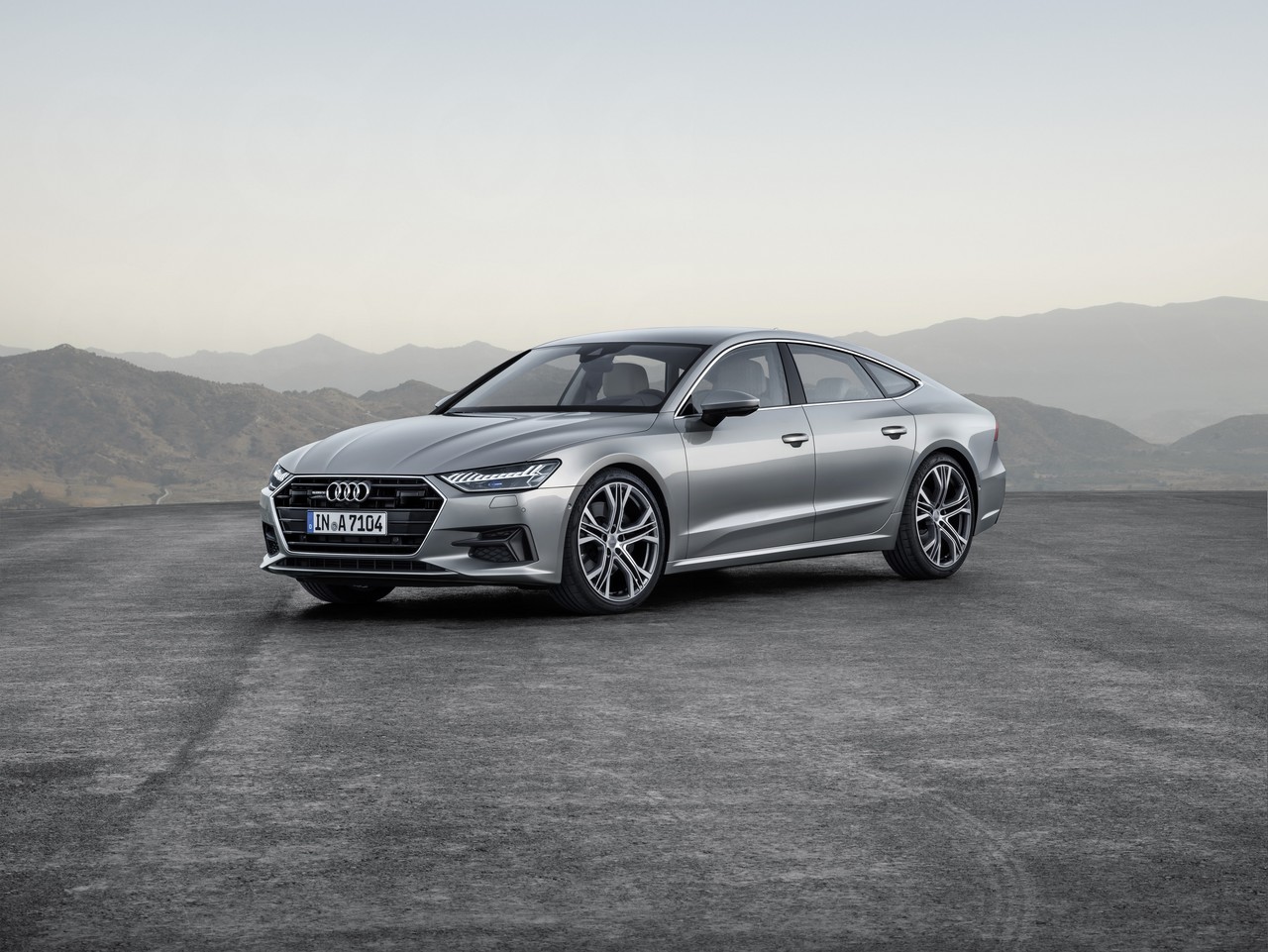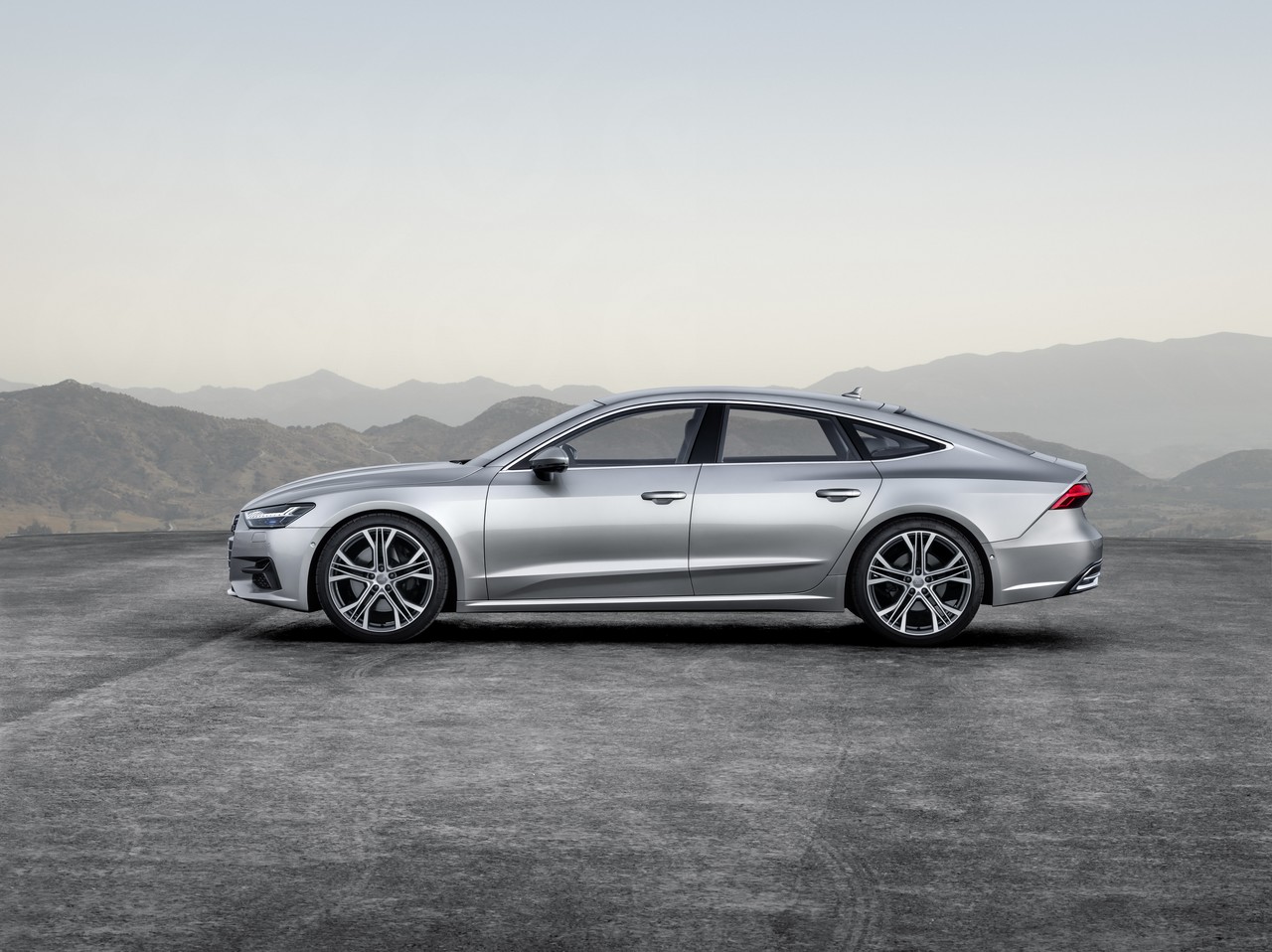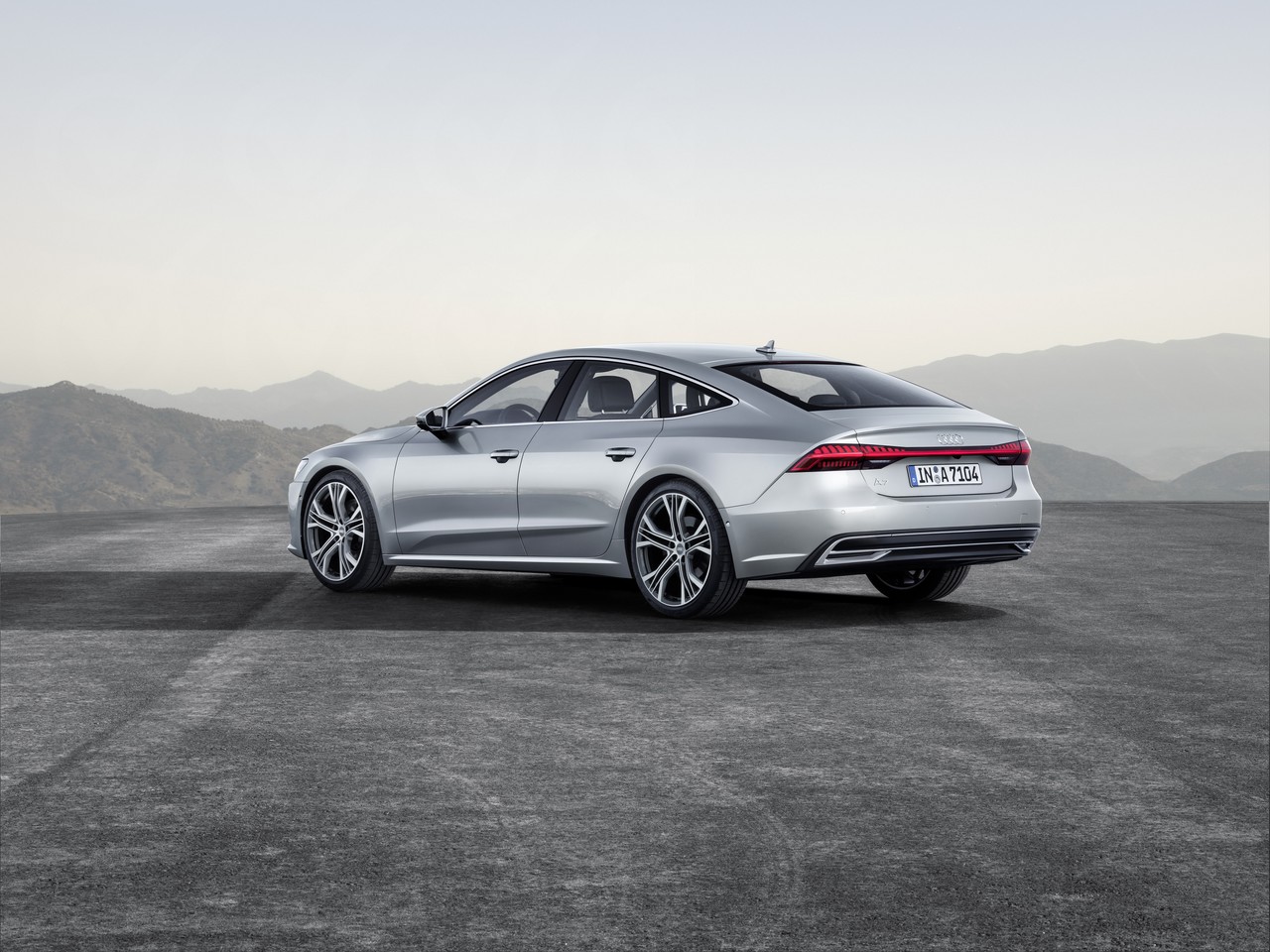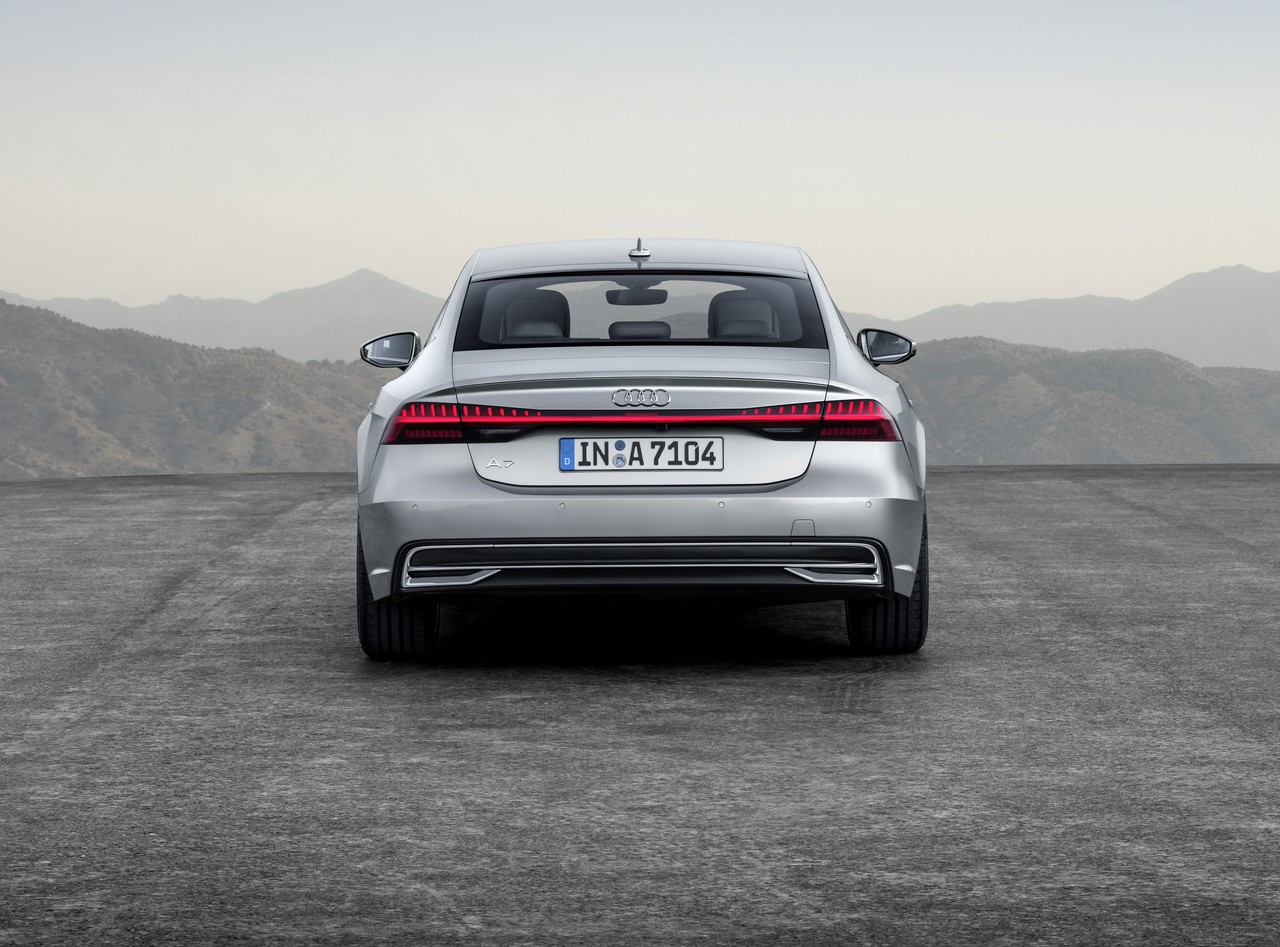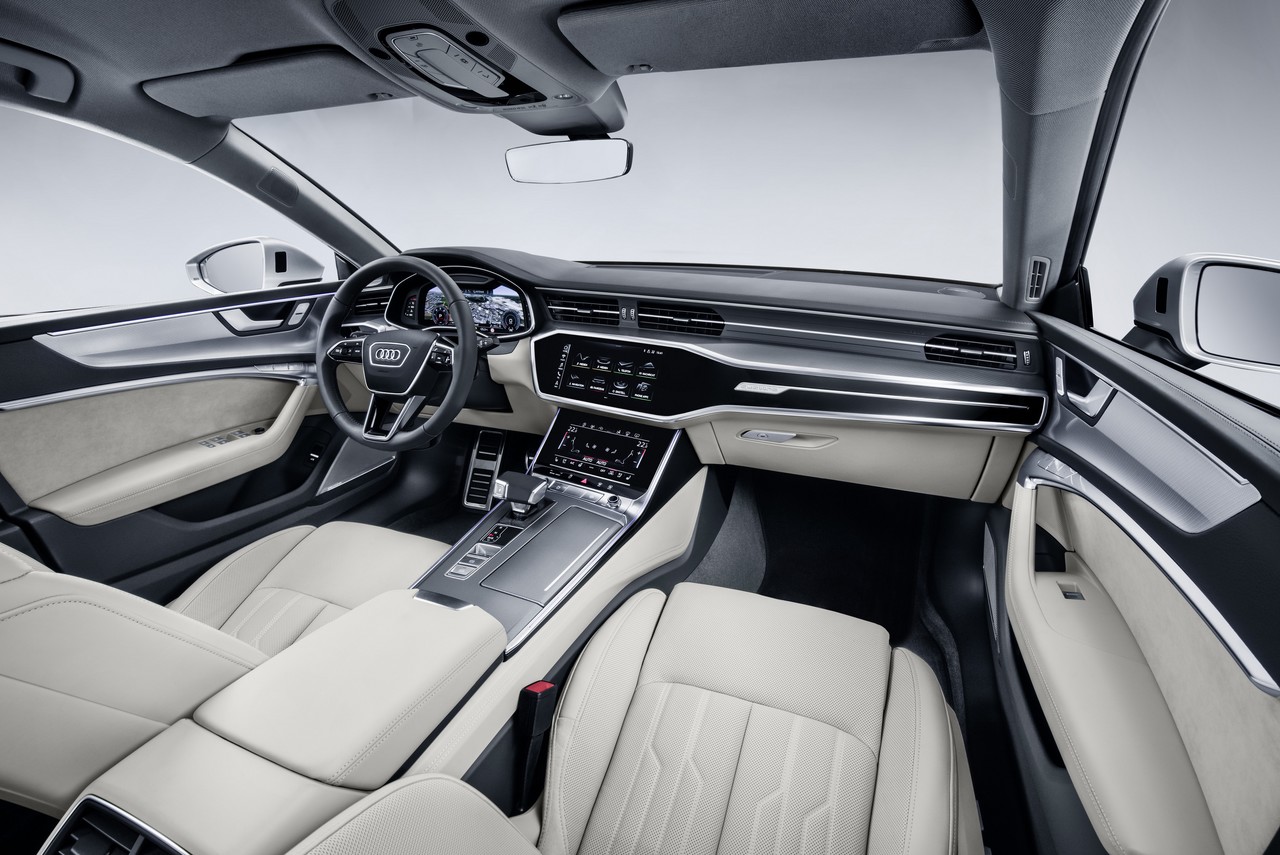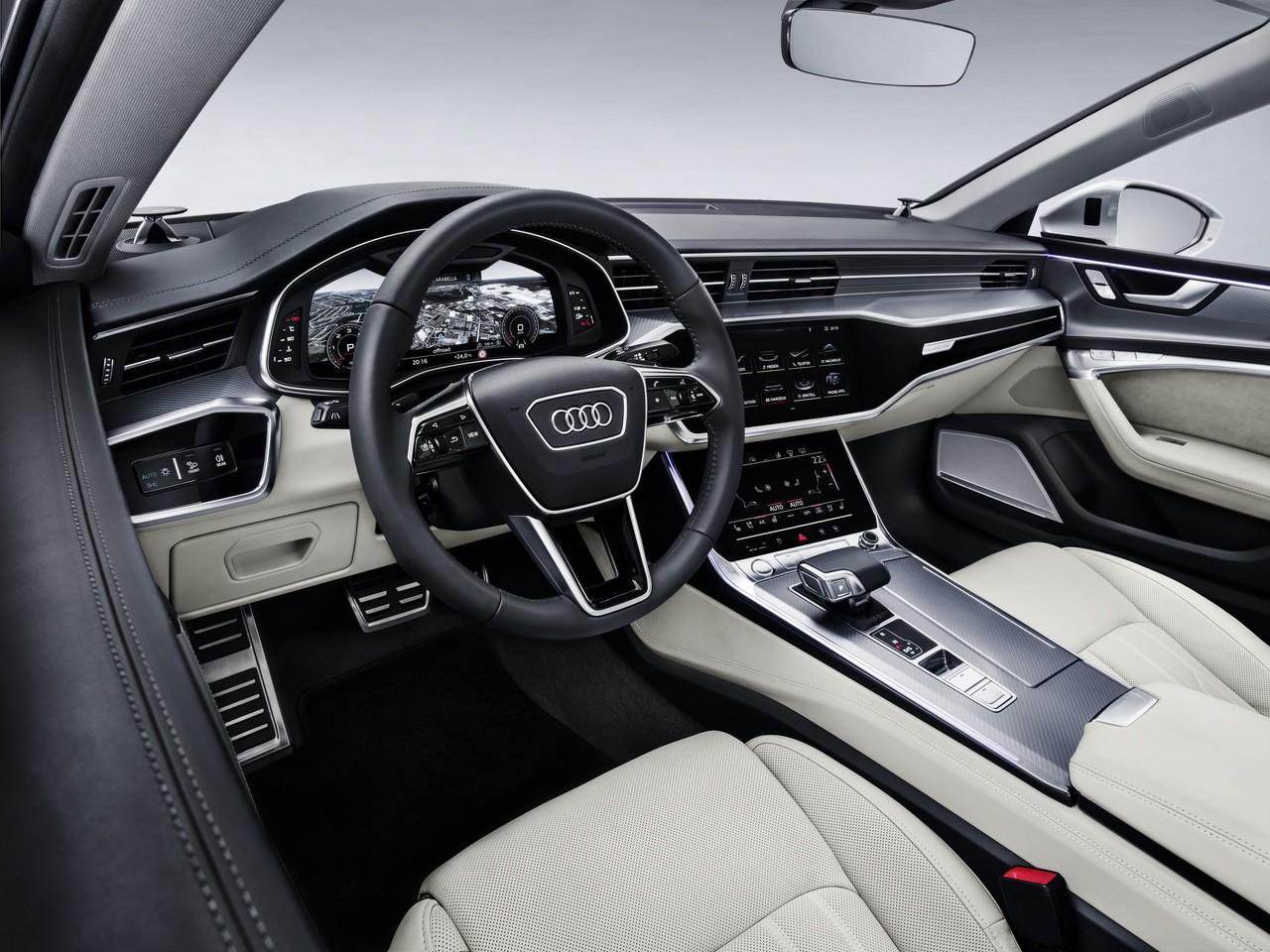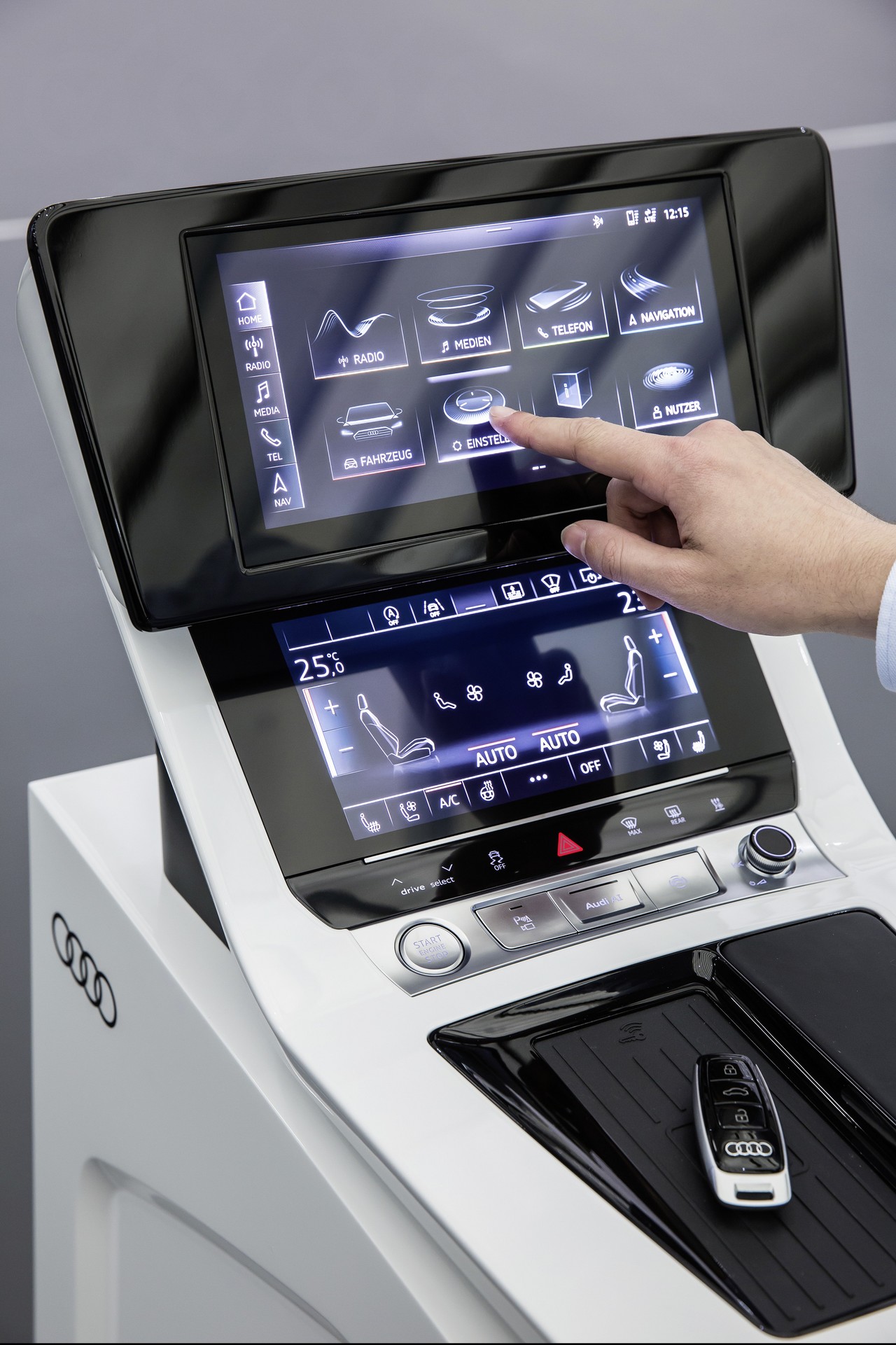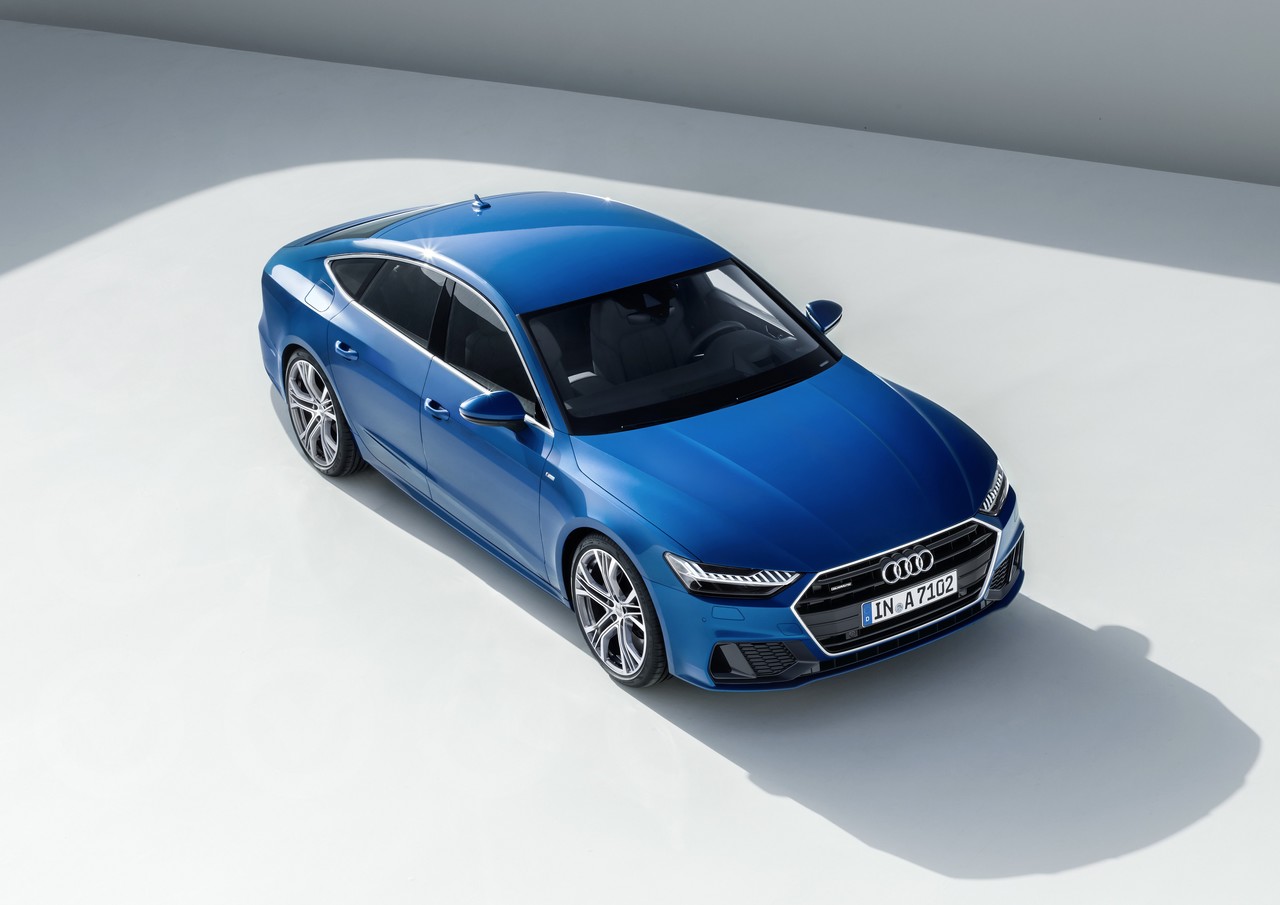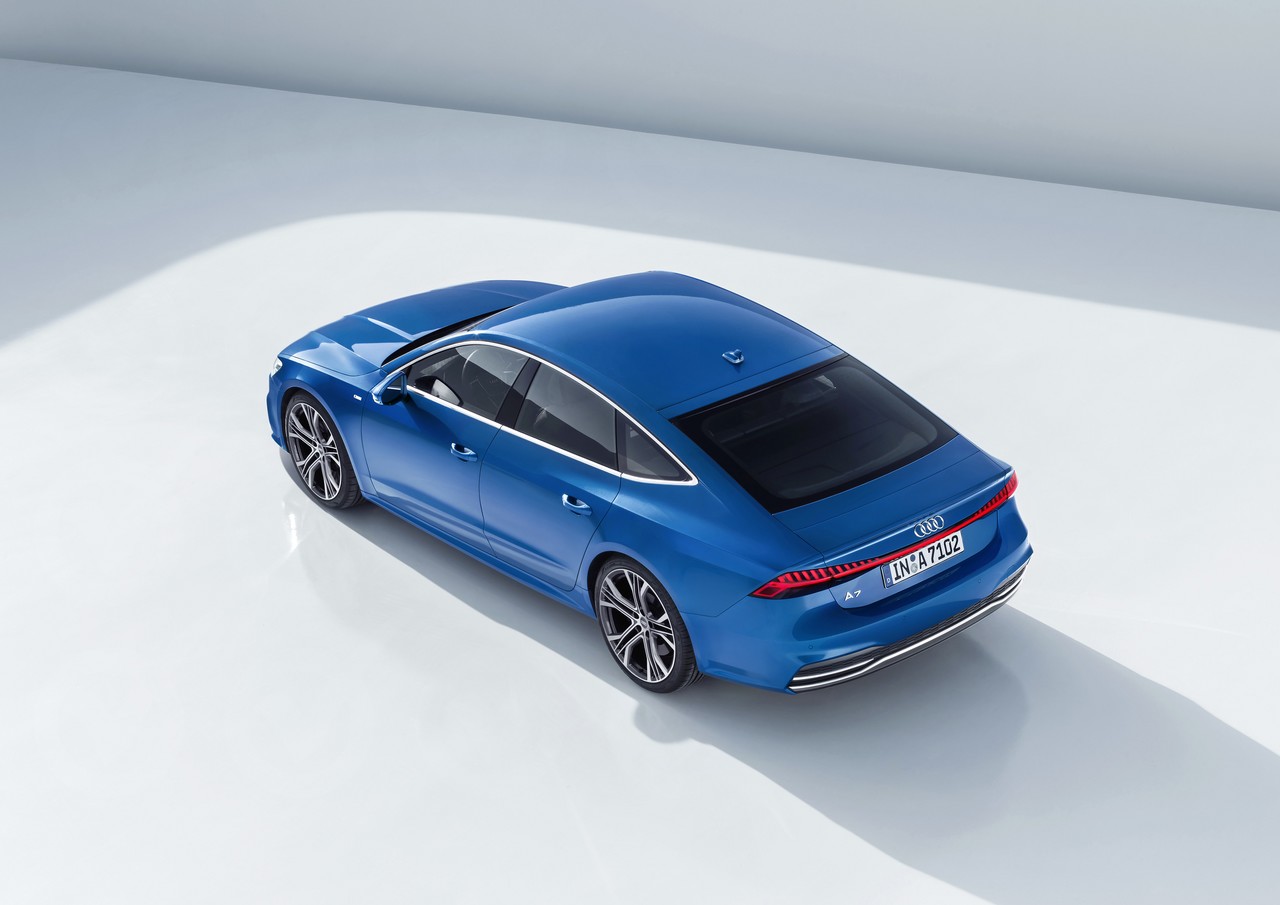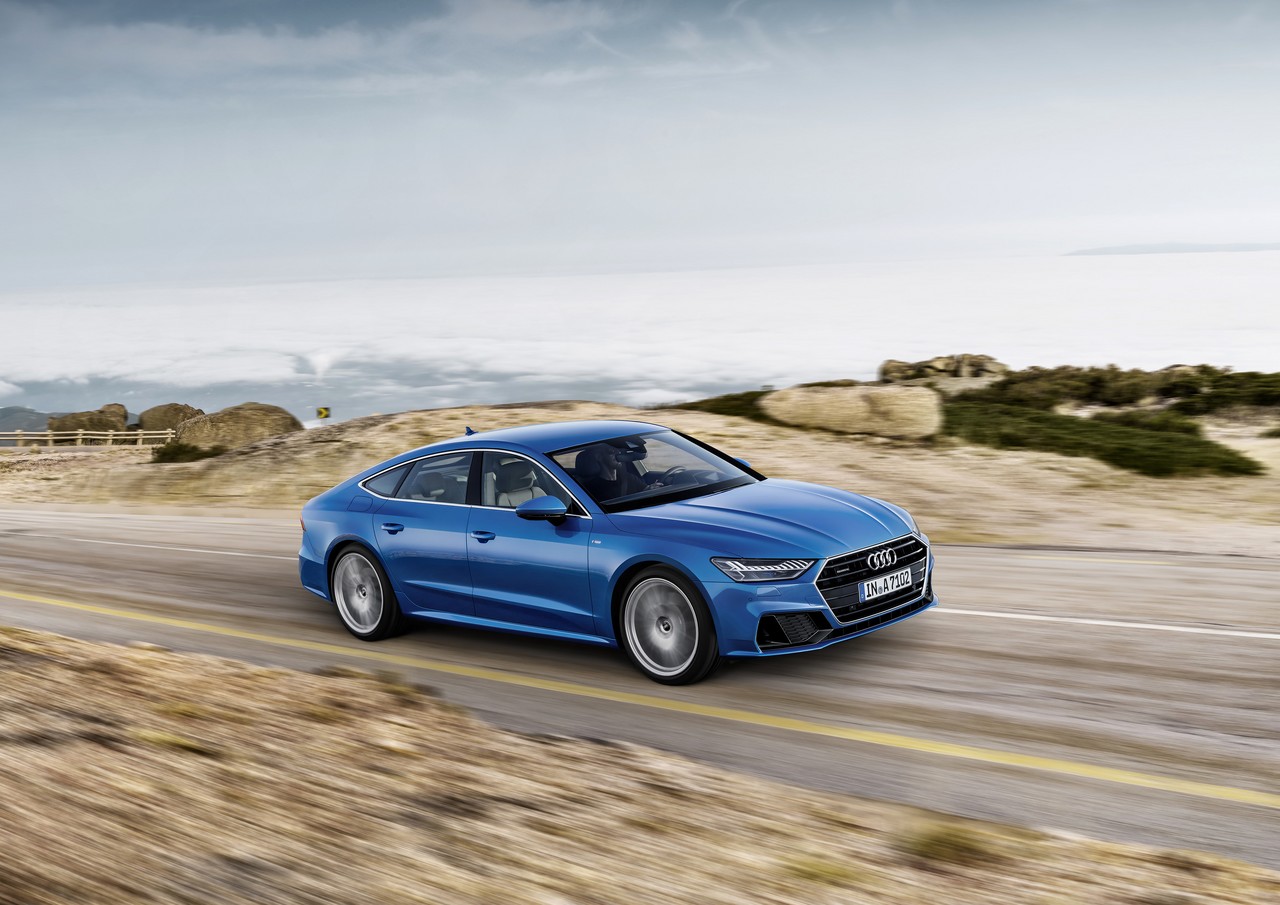
- Responsive biturbo V6 petrol engine
- Comfortable and supportive front seats
- High standard of interior fit and finish
- Touchscreens and digital displays work well
- Good body control
- Large boot…
- … though luggage does have to be lifted over a lip
- ‘quattro’ all-wheel drive system for 55 TFSI is predominantly front wheel drive
- Suspension designed for autobahns and lacks compliance
- Steering is light and lacks feel
- Transmission tunnel means centre rear seat is only suitable for children
Overview
Released in Australia in October 2018, the Audi C8 (or Typ 4K) A7 Sportback was a five-door liftback. Manufactured in Neckarsulm, Germany, the Audi C8 A7 Sportback was initially available as a 55 TFSI quattro variant.
Audi described the A7 Sportback 55 TFSI as a ‘mild hybrid electric vehicle’ (MHEV) because it had a 48-volt primary electrical system and a belt alternator starter (BAS) which generated up to 12 kW of recuperation power. As result, the A7 Sportback could coast with the engine off for up to 40 seconds at speeds between 55 km/h and 160 km/h, and then smoothly restart the engine via the BAS when needed. Furthermore, the engine’s start-stop function could activate when the vehicle was travelling at speeds of 22 km/h.
The Audi C8 A7 Sportback 55 TFSI quattro could accelerate from rest to 100 km/h in 5.3 seconds. Over the combined ADR 81/02 test cycle, its fuel consumption was 7.3 litres per 100 km.
Mild-hybrid system (MHEV)
For the 3.0 TFSI or 3.0 TDI engines, the Audi C8 A7 Sportback will be available as a ‘mild hybrid electric vehicle’ (MHEV). The MHEV system is based on a 48-volt primary electrical system and a belt alternator starter (BAS) which generates up to 12 kW of recuperation power. As result, the A7 Sportback can coast with the engine off for up to 40 seconds at speeds between 55 km/h and 160 km/h, and then smoothly restart the engine via the BAS when needed. Furthermore, the start-stop can activate when the vehicle is travelling at 22 km/h.
| Variant | Engine | Trans. | Peak power | Peak torque |
|---|---|---|---|---|
| 55 TFSI quattro | 2995 cc CZSE (EA839) turbo petrol V6 | 7sp DCT | 250 kW at 5000-6400 rpm | 500 Nm at 1370-4500 rpm |
‘quattro’ all-wheel drive systems
For the Audi C8 A7 Sportback models with double clutch transmissions (Audi’s ‘S tronic’), the on-demand all-wheel drive system transmitted the engine’s torque to the front wheels in normal conditions. If a loss of traction was experienced or anticipated, then a multi-plate clutch would engage to transmit up to 50 per cent of the engine’s torque to the rear wheels.
Beyond the all-wheel drive system, the Audi C8 A7 Sportback had a wheel selective torque control function which could brakes the two inside wheels when cornering to prevent them from spinning. As an extra-cost option, the Audi A7 Sportback could also be specified with a ‘sport differential’ which actively distributed drive torque between the rear wheels.
Body and dimensions
The Audi C8 A7 Sportback was underpinned by Volkswagen AG’s MLBevo platform which was shared with the Audi C8 A6 and Audi D5 A8 . As such, Audi described the body of the A7 Sportback as an ‘ultra-high-strength composite’ which used:
- Hot-formed steel components for 23.9 per cent of the body structure (by weight), including the lower section of the front bulkhead, the side sills, the rear cross member, the B-pillars and the front zone of the roof line;
- Cast aluminium for the strut dome and roof frame reinforcements;
- Extruded aluminium sections for the engine strut brace and central underfloor cross brace;
- An aluminium sheet to support the B-pillars;
- A steel/polymer composite to support the upper shell of the rear roof frame; and,
- In other areas of the body, tailored sheet metal blanks – created by partial tempering and rolling or welding – that were between 0.75 mm and 2.05 mm thick.
Compared to the original Audi C7 A7 Sportback, the C8 A7 Sportback was the same length (4969 mm), 3 mm narrower (1908 mm), 2 mm taller (1422 mm) and had a 12 mm longer wheelbase (2926 mm). The luggage compartment had a volume of 535 litres which increased to 1390 litres when the rear seats were folded down.
The Audi A7 Sportback had a drag co-efficient of 0.27 Cd and a rear spoiler that was integrated into the luggage compartment lid. When vehicle speed exceeded 120 km/h, the spoiler would automatically extend; at 120 km/h, it provides approximately 50 kg of downforce on the rear axle.
Suspension
The Audi C8 A7 Sportback had five-link suspension – front and rear – that were mounted on sub-frames. The A7 Sportback also has three suspension options –
- Sports suspension: reduced body height by 10 mm;
- Adaptive damper control (standard for Australian deliveries of the A7 Sportback 55 TFSI): consisted of electronically-controlled shock absorbers with ‘comfort-oriented management’ such that higher current only flowed when the valves were closed to increase shock absorber resistance; and,
- Adaptive air suspension (includes including electronically-controlled dampers): had three modes, a ‘lift’ position for poor roads and an automatic levelling function. In ‘auto’ and comfort’ modes, the body was lowered by 10 mm at speeds of 120 km/h and above for greater stability and reduced air resistance.
Steering
The Audi C8 A7 Sportback had rack-and-pinion steering with electric power assistance. The variable steering ratio could range from 9.5:1 to 16.5:1 and became more direct as steering angle increased.
As an extra-cost option, the C8 A7 Sportback was available with rear-wheel steering –
- At speeds up to 60 km/h, the rear wheels could turn in the opposite direction to the front wheels by up to five degrees to improve manoeuvrability and reduce the turning circle by up to 1.1 metres; and,
- At speeds above 60 km/h, the rear wheels turned in the same direction as the front wheels for greater stability.
Safety equipment
Standard safety equipment for the Audi C8 A7 Sportback included dual front airbags, front and rear seat-mounted airbags, full-length curtain airbags (i.e. for front and rear occupants), ABS, electronic brake force distribution, brake assist, electronic stability control, traction control and front seatbelts with pre-tensioners and load limiters.
For its active safety technologies, the Audi C8 A7 Sportback was fitted with the following sensors:
- Twelve ultrasonic sensors on the front, sides and rear;
- Four 360 degree cameras on the front, rear and door mirrors;
- One front camera at the top edge of the windscreen;
- Four mid-range radars at the vehicle’s corners;
- A long-range radar on the front; and,
- A laser scanner mounted in the front bumper. The laser scanner emitted light pulses on several vertical planes which were distributed by a mirror over a field about 80 metres deep and through a range of 145 degrees. Since the wavelengths of the pulses were in the near infra-red range, they were not visible to the human eye. The pulses were reflected by objects in front of the car, detected by photodiodes in the laser scanner and then interpreted for a contoured image of the surroundings.
For the Audi C8 A7 Sportback, a central driver assistance controller (zFAS) formed a comprehensive image of the surroundings from the sensor data. The zFAS controller was approximately the size of a tablet computer and integrated high-performance computers from NVIDIA (Tegra K1), ALTERA (Cyclon V), Infineon (Aurix) and the EyeQ3 image processor from Mobileye.
Standard active safety technologies for Australian deliveries of the Audi C8 A7 Sportback included –
- Adaptive Cruise Assist (ACA): extended Adaptive Cruise Control (ACC) by adding a lane tracking function. ACA operated at speeds from rest to 250 km/h to keep the vehicle at the desired distance from the vehicle ahead and used ‘slight steering interventions’ to help the driver stay in their lane. ACA could be supplemented by ‘predictive control’ and ‘efficiency assist’ to enable an anticipatory driving style. To detect the traffic situation and course of the route, camera images and navigation were combined. If ACC was deactivated, ‘efficiency assist’ indicated to the driver when they should ease off the accelerator;
- Pre sense front: operated at speeds up to 250 km/h and could prevent front-to-rear collisions or reduce their severity. In hazardous situations, the driver would receive visual and acoustic warnings to apply the brakes, followed by a brief application of the brakes for a jolting effect to alert the driver. If the driver failed to respond, the A7 Sportback would decelerates to the greatest possible extent if the vehicle ahead of it was still moving;
- Lane departure warning: active at speeds above 60 km/h, lane departure warning would warn the driver if they were about to cross lane markings and applied ‘corrective steering intervention’ to prevent the lane departure. The driver could also select a setting so that the steering wheel would vibrate as an additional warning;
- Audi side assist (also known as ‘lane change warning’): operating at speeds above 15 km/h, Audi side assist used two rear radar sensors to monitor traffic up to 70 metres behind the vehicle. If another vehicle approached quickly or was in the driver’s blind spot, a warning LED in the housing of the appropriate door mirror would illuminate. If the driver activated the indicator to change lanes, LEDs would blink rapidly to warn the driver;
- Turning assist (also ‘intersection crossing assist’): active at speeds from 2 km/h to 10 km/h, ‘turning assist’ operated once the driver activated the right-hand turn signal (for RHD vehicles) and could monitor oncoming traffic. In hazardous situations, the brakes could be applied to bring the vehicle to rest;
- Cross traffic assist rear: when reversing at low speeds, rear cross-traffic assist used the rear radar sensors to detect approaching traffic. If approaching traffic was detected which may cross the vehicle’s path, the driver would receive warnings (visual, acoustic and a brief, jolting application of the brakes);
- Audi pre sense rear: could warn of potential collisions from behind, alert following traffic by rapidly flashing the brake lights and activate the ‘pre sense basic’ protection measures described below;
- Swerve Assist: operating at speeds between 30 km/h and 150 km/h when the driver was taking evasive action. In such situations, swerve assist applied small amounts of steering torque to adjust steering angle so that the vehicle avoided detected obstacles;
- Exit warning: activated when the vehicle was stationary, exit warning would warns occupants if vehicles were approaching from behind by illuminating red fibre optics in the door-opening mechanism as the doors were opened;
- Attention assist: monitored driver behaviour and issued a warning if the driver was assessed to be ‘inattentive’; and,
- Pre sense basic: initiated occupant protection measures such as tightening the front seatbelts, closing the windows and sunroof (where fitted), and activating the hazard lights if ‘unstable driving conditions’ are detected or a collision was anticipated.
Wheels and tyres
The Audi C8 A7 Sportback 55 TFSI quattro had 8.5J x 20-inch alloy wheels with 255/40 R20 tyres.
Features: Audi C8 A7 Sportback 55 TFSI quattro
For the Audi C8 A7 Sportback, the ‘MMI navigation plus’ system used Audi’s ‘MIB 2+’ Modular Infotainment Platform – this included a Wi-Fi hotspot that supported the 5 GHz band and LTE Advanced transmission for 300 Mbit/s downloads and 50 Mbit/s uploads (peak theoretical speeds). The infotainment system also included a 705 watt Bang & Olufsen 3D sound system with sixteen speakers and a fifteen channel amplifier, digital radio tuner (DAB+), DVD player, USB connection for smartphones (‘Audi smartphone interface’), USB connections for charging and data transfer from music devices (‘Audi music interface’) and wireless mobile phone charging.
The interior of the Audi A7 Sportback included a 10.1 inch upper display for the infotainment system and an 8.6-inch lower display for climate control, seat adjustment, convenience functions and could be used for handwriting recognition or as a virtual keyboard. Furthermore, the ‘Audi virtual cockpit’ consisted of a 12.3-inch digital instrument cluster that provided full HD resolution in 1920 x 720 pixels.
Beyond this, standard features for the Audi C8 A7 Sportback 55 TFSI quattro included Valcona leather upholstery, power adjustable front seats with heating, three-zone climate control air conditioning, dusk-sensing headlights, rain-sensing wipers, a head-up display, a leather-wrapped steering wheel with gearshift paddles, remote central locking with proximity key, power adjustable and heated door mirrors with auto-dimming and kerbside function for the passenger side, power windows, a power adjustable steering wheel (tilt and telescopic), an auto-dimming interior mirror, a power-operated tailgate, memory settings (mirrors), LED interior lighting, two 12 volt power sockets, an alarm and immobiliser.
Headlights
As standard, the Audi C8 A7 Sportback is fitted with LED headlights. For Australian-delivered vehicles, however, the C8 A7 Sportback 55 TFSI quattro had Audi’s ‘HD Matrix LED’ headlights in which the top section contained the daytime running lights and the dipped beam modules. The lower section houses other lighting functions such as the cornering and turning lights. Available as an extra-cost option, Audi’s ‘laser high beam’ added an X-shaped optically focusing metal shutter and a blue-illuminated light guide to the lower section. The laser spot would be activated at 70 km/h and doubled the range of the high beam.
Brochure
Related links
